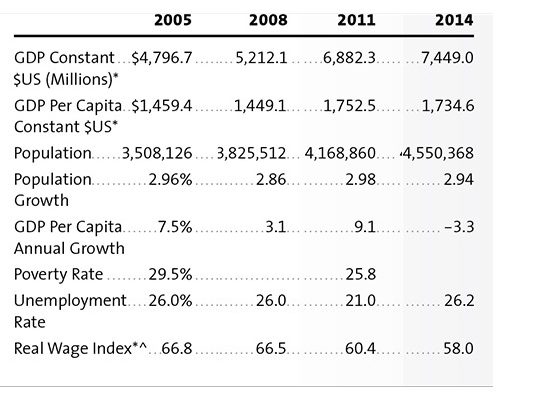Even for the most narrow focus and tunnel-vision of economists, it would, of course, be ludicrous to claim that economic issues are foremost among the disputations surrounding the Palestinian territories of the West Bank and the Gaza Strip. But the economic issues are far from nugatory, either. When you have a population with a per capita GDP below $2,000, when unemployment among young men aged 15-24 is often near 40%, when wages have been falling for a decade, and when foreign aid has recently fallen from one-third of GDP to 6% of GDP, then the economic situation is going to be part of what is generating turmoil and discontent.Â
Jacob Udell and Jacob Udell and  which appears in the most recent issue of the Milken Institute Review (Second Quarter 2017, 19:2, pp. 78-85). For additional background, the World Bank has published the “Economic Monitoring Report Economic Monitoring Report (May 4, 2017), and the IMF has published “West Bank and Gaza: Report to the Ad Hoc Liason Committee” (April 10, 2017). Here, I’ll draw on all three report.
Udell and Yago describe the problems of the economy of the West Bank and Gaza in some detail. Here’s a trimmed-down version of a table from their article (I’m showing three-year intervals, rather than every year).

For example, Udell and Yago write:
“Though the labor force participation rate is currently at its highest since 2000 (at an unimpressive 46 percent), it has been accompanied by an overall spike in unemployment — implying that the net entry of job seekers into the market exceeds the ability of the economy to create employment. Meanwhile, the Palestinian Authority has also become the employer of last resort, with 23 percent of the workforce on its rolls. The wave of youth entering the labor market in the past decade, coupled with the frictional and structural unemployment of the adult population and almost nonexistent job growth, has left youth unemployment at alarming levels. Since 2001, for instance, unemployment among males aged 15–24, which seems to function as a leading indicator of civil unrest, has averaged 35 to 40 percent and reached 43 percent in 2014.”
“Since 2005, real average wages have decreased by some 10 percent, while unemployment remains at around one-quarter of the labor force, and average GDP growth lags behind population growth by 2.6 percent per year.”
“And while considerable sums flow into the territories from overseas Palestinians, there are no “diaspora bonds†or other vehicles to facilitate investment by Palestinian ex-pats (whose wealth estimates by the World Bank have varied from $40 billion to $80 billion). One mark of a lack of confidence in the economy: Palestinian investment abroad in 2015 was $5.9 billion — $1.3 billion more than foreign investment in Palestine.”
Along similar lines, the World Bank report notes:
“Currently, only 40 percent of those aged between 15 and 29 are active in the labor market, reflecting high pessimism regarding employment prospects. Despite a low participation rate, unemployment amongst this category reached 27 percent in 2016 in the West Bank and a staggering 56 percent in Gaza. … In the medium term, real GDP growth is projected to hover around 3.3 percent. This growth level implies a stagnation in real per capita income and an increase in unemployment. Moreover, downside risks remain significant. As mentioned earlier, the [government budget] financing gap for 2017 is unprecedented in terms of its size, and risks significant economic and social consequences if it is not closed through additional finance or policy measures.”

